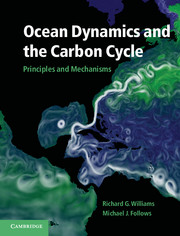Book contents
- Frontmatter
- Contents
- Preface
- Acknowledgements
- Illustration credits
- Part I Introduction
- Part II Fundamentals
- Part III Physical Phenomena and their Biogeochemical Signals
- 7 Seasonality of the upper ocean
- 8 Ocean gyres and intense currents
- 9 Ocean eddies
- 10 Ventilation
- 11 Cycling and transport of nutrients and carbon
- 12 The deep ocean and overturning
- Part IV Synthesis
- Appendix
- Symbols and definitions
- Glossary
- Answers
- References
- Index
- Plate section
10 - Ventilation
from Part III - Physical Phenomena and their Biogeochemical Signals
Published online by Cambridge University Press: 05 June 2012
- Frontmatter
- Contents
- Preface
- Acknowledgements
- Illustration credits
- Part I Introduction
- Part II Fundamentals
- Part III Physical Phenomena and their Biogeochemical Signals
- 7 Seasonality of the upper ocean
- 8 Ocean gyres and intense currents
- 9 Ocean eddies
- 10 Ventilation
- 11 Cycling and transport of nutrients and carbon
- 12 The deep ocean and overturning
- Part IV Synthesis
- Appendix
- Symbols and definitions
- Glossary
- Answers
- References
- Index
- Plate section
Summary
Tracers are transferred throughout the atmosphere and ocean, for example, as you see when watching black smoke billow out of a chimney stack and spread across the skyline, or in how a silt-laden river flows out to sea. In a similar manner, tracers are transferred from the surface mixed layer into the ocean interior, as depicted for the spreading of CFCs in Fig. 10.1; this process is generically referred to as ventilation. This ventilated transfer controls the physical properties of much of the ocean and the communication between the atmosphere and ocean interior.
Ventilation does not occur uniformly over the globe, like heat diffusing down a pipe, instead, some parts of the ocean are well ventilated and other parts are poorly ventilated. For example, the North Atlantic is well ventilated, with relatively high concentrations of CFCs spreading from the surface mixed layer, while the mid-depth and bottom waters of the North Pacific are poorly ventilated, with CFCs being absent (Fig. 10.1).
In this chapter, we describe the ventilation process by mapping how tracers spread over the globe, examining property distributions along potential density surfaces (with maps repeated in the colour plates 8 to 15). We then discuss the mechanisms by which fluid is transferred from the mixed layer, focussing on diagnostics for the North Atlantic, and include simple theoretical models for how the upper thermocline is formed.
How does ventilation vary over the globe?
To gain a conceptual view of ventilation, consider a water parcel, a small amount of fluid with constant mass, initially residing within the mixed layer.
- Type
- Chapter
- Information
- Ocean Dynamics and the Carbon CyclePrinciples and Mechanisms, pp. 236 - 259Publisher: Cambridge University PressPrint publication year: 2011



